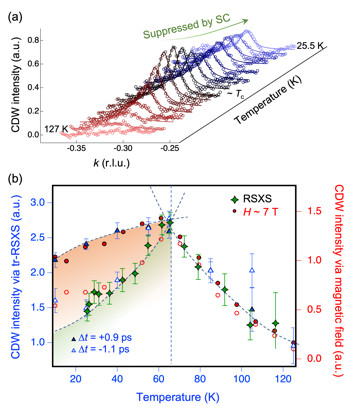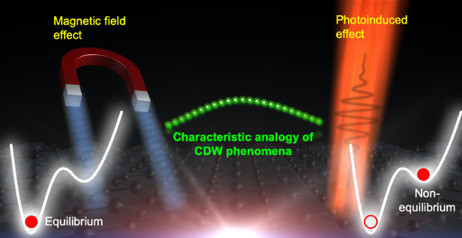Since the discovery of unconventional high-temperature superconductivity (HTSC) in 1986, one of the central issues has been to understand the unusual properties in the normal state. For example, the so-called pseudogap phase occurs in the normal state above the superconducting critical temperature (Tc). It is believed that the phenomena of the pseudogap and its corresponding mechanism might provide a clue on how to reach an even higher Tc, ultimately achieving a room-temperature superconductor. A relevant issue is that the understanding the normal state (i.e., ground-state problems) has been critical.

Fig. 1: (a) Temperature dependence of CDW in YBCO, measured by RSXS (BL13-3 at SSRL). The arrow denotes the suppressed CDW order. (b) Order parameters measured by RSXS, tr-RSXS, and magnetic field scattering. The green- and orange-colored shades below Tc denote the suppressed and enhanced CDW (normal state) portion, respectively.
To address the ground-state problems, we must study the samples at low temperature. This is because a system needs to have the lowest possible energy state. Unfortunately, in many HTSC cases, mostly high-Tc cuprates, it is difficult to access the normal state at low temperature. Since the superconductivity (SC) is developed at an even higher temperature, the normal state becomes buried by the competition with SC. In this sense, we must quench the superconducting state, aiming to resolve this difficulty. An external magnetic field approach [1,2] or an optical pump approach [3,4] are typically employed for the quenching SC. These two approaches have been successfully demonstrated. However, it is still premature to conclude that the normal states obtained by the two approaches are the same. It is because findings through the pump-probe approach represent the fundamental physics of the non-equilibrium state, while the magnetic field study probes the equilibrium state. Thus, it is timely to establish a scientific connection between the equilibrium state and the non-equilibrium state in HTSC.
Here, we explore charge density wave (CDW) phenomena commonly shown in high-Tc cuprates, which are relevant to the physics of the normal state, by using complementary x-ray scattering measurements at both synchrotron (BL13-3 at SSRL) and free-electron laser (PAL-XFEL and SACLA) facilities. In this work, we employed YBa2Cu3O6.67 (YBCO) cuprate, because its CDW phenomena have been well-established under the equilibrium state (i.e., the approach through the high-magnetic field) [5,6].
Figure 1(a) shows the temperature dependence of static CDW of the YBCO crystal, which was measured by resonant soft x-ray scattering (RSXS). We observed CDW peak at Q = (0, qcdw, ~1.45) where qcdw is around -0.32 reciprocal lattice unit (r.l.u.) in the CuO2 plane. The CDW appears below ~150 K, which is consistent with previous studies. As expected, the CDW is suppressed while the superconducting state emerges below Tc = 65.5 K. This suppression demonstrates the existence of competition between CDW and SC in YBCO, resulting in the weakened normal state. In this sense, to investigate a low-temperature state of CDW, the SC needs to be quenched.
As shown in Fig. 1(b), we observed that the weakened CDW is reinforced by applying the external magnetic field that quenches the SC state, which is consistent with previous work [5,6]. In particular, when the optical pump quenches the SC state, we also observed a similar analogy to the competition between superconductivity and CDW shown in the equilibrium state. We further observe that the broken pairing states in the superconducting CuO2 plane via the optical pump led to nucleation of three-dimensional CDW precursor correlation demonstrated under the magnetic field.

In summary, using the comprehensive x-ray scattering studies on the CDW behavior in YBCO, we first observed competition between the CDW and SC even in the non-equilibrium state driven by the optical pump. Second, we revealed its characteristic similarities with CDW phenomena under magnetic fields, implying a common ground of normal states attained by a magnetic field and an optical pump. Ultimately, these findings provide a critical clue that the characteristics of the photoinduced normal state show a solid resemblance to those under magnetic fields in equilibrium conditions (see Figure 2). In addition, we suggest that the broken Cooper-pairing physics in the non-equilibrium state could be applied in the context of nucleating the vortex state under the external magnetic field. On the other hand, this demonstration opens up huge opportunities, including the possibility that other materials could be nudged into a transient superconducting state with light.
[1] G. Grissonnanche et al., “Direct Measurement of the Upper Critical Field in Cuprate Superconductors”, Nat. Commun. 5, 3280 (2014). http://doi.org/10.1038/ncomms4280
[2] J. B. Kemper et al., “Thermodynamic Signature of a Magnetic-field-driven Phase Transition within the Superconducting State of an Underdoped Cuprate”, Nat. Phys. 12, 47 (2016). http://doi.org/10.1038/nphys3502
[3] R. A. Kaindl et al., “Ultrafast Mid-Infrared Response of YBa2Cu3O7-δ”, Science 287, 470 (2000). http://doi.org/10.1126/science.287.5452.470
[4] P. Kusar et al., “Controlled Vaporization of the Superconducting Condensate in Cuprate Superconductors by Femtosecond Photoexcitation”, Phys. Rev. Lett. 101, 227001 (2008). http://doi.org/10.1103/PhysRevLett.101.227001
[5] S. Gerber et al., “Three-dimensional Charge Density Wave Order in YBa2Cu3O6.67 at High Magnetic fields. Science 350, 949 (2015). http://doi.org/10.1126/science.aac6257
[6] H. Jang et al. Ideal charge-density-wave order in the high-field state of superconducting YBCO. Proc. Natl Acad. Sci. USA 113, 14645 (2016). http://doi.org/10.1073/pnas.1612849113
H. Jang, S. Song, T. Kihara, Y. Liu, S.-J. Lee, S.-Y. Park, M. Kim, H.-D. Kim, G. Coslovich, S. Nakata, Y. Kubota, I. Inoue, K. Tamasaku, M. Yabashi, H. Lee, C. Song, H. Nojiri, B. Keimer, C.-C. Kao, J.-S. Lee*, “Characterization of Photoinduced Normal State through Charge Density Wave in Superconducting YBa2Cu3O6.67 at High Magnetic Fields”, Sci. Adv. 8, eabk0832 (2022) doi: 10.1126/sciadv.abk0832




